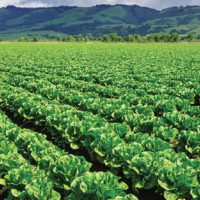Lettuce may not be as green as you thought

That wilted roughage that sits atop your burger, at best of dubious nutritious value, may leave a disproportionately large carbon footprint. Consider the work it took to chop, chill, and transport lettuce to your favorite burger joint. Researchers from Carnegie Mellon University found that, on a per-calorie basis, lettuce production results in a three-fold increase in greenhouse gas production.
In the US, 166,800 acres of land are earmarked for lettuce production and, in 2015, this totaled some 8,087 million pounds. Valued at $1.9 billion, this makes lettuce the leading vegetable crop. Arizona and California grow over 95% of the US lettuce supply, but both are frequently affected by droughts that can severely limit production. Worldwide, about 26.1 million tons were grown in 2015 with China producing 56% of the total.
After harvest, the lettuce is cooled and cold-shipped to maintain its crunch. Michigan State University researchers analyzed leaf lettuce production and found that, in a scenario where lettuce is grown in California and shipped to Michigan, it accounts for 4.3 times the CO2 footprint per kilogram of lettuce when compared to the same lettuce grown locally.
Vertical farms have taken that factoid and run with it. Two companies, Crop One Holdings and Emirates Flight Catering are betting $40 million on the idea.
Vertical farming, as its name suggests, combines multiple vertical layers of hydroponic plants. By growing indoors and controlling the light, temperature, water and carbon dioxide level of the area, plants like lettuce can be produced year-round worldwide. Moreover, the lettuce could be available to local grocers sooner, vastly reducing its carbon footprint.
The joint venture between Crop One Holdings and Emirates Flight Catering creates the largest vertical farm in existence (130,000 square feet) in Dubai, capable of producing three tons of produce per day. As a point of reference, the average American eats about 415 pounds of veggies each year. This has implications for the projected rise in population, 80% of whom are predicted to live in urban areas miles from their nearest farmer and the roughly 109 hectares of new land required to feed them. That’s 20% bigger than Brazil.
That’s a whole lot of green—in more ways than one.
